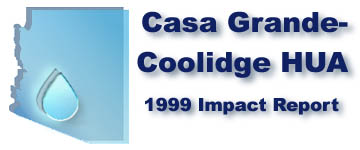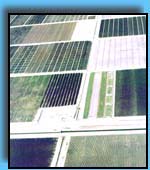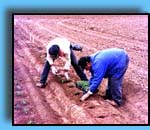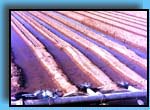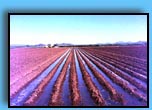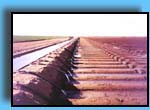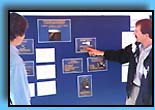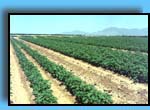|
|
|||||||||||||||||||||||||||||||
|
NUTRIENT AND PESTICIDE
MANAGEMENT IMPACT 1 As part of the development of LTAs (Long Term Agreements) within the project area, Natural Resources Conservation Service (NRCS) has worked with growers to identify alternatives to improve water quality. The following assistance has been provided on 12,695 acres of irrigated CGCHUA cropland: 1. Existing nutrient and pesticide management practices were identified. 2. Alternatives identified for pesticides on growers' farms. 3. Soil-pesticide relationships were identified and discussed. 4. Nutrient management systems were planned and implemented. IMPACT 2 In the past, many growers made a common practice of applying 100% of the required nitrogen for a season at pre-plant, i.e. before the seed ever touches the ground. According to the Arizona Agricultural Statistics, approximately 12% of growers followed this practice in 1991. However, through educational efforts developed by the HUA Projects, growers have been able to rethink and revise this strategy. By 1993, the number of Arizona growers still using this nitrogen application method dropped to 3%. |
|||||||||||||||||||||||||||||||
|
IMPACT
3 In the 1991 CGCHUA Agricultural Producer Survey, 54% of area producers responded that they use soil analysis to determine crop needs for fertilizer. Upon receipt of the 1994 follow-up survey, the percentage of producers using soil analysis had increased to 67%. The percentage of producers using petiole analysis to determine crop needs for fertilizer also increased slightly. IMPACT 4 In 1995, one of the CGCHUA Project's goals was to apply water quality practices to 65 acres of crop/hay which were counted among those impairing water quality. The CGCHUA Project was able to meet that goal through nitrogen management practices. |
|||||||||||||||||||||||||||||||
|
IMPACT 5 In 1995, two educational demonstrations were established in irrigation and nitrogen management utilizing BMPs (Best Management Practices). The demonstrations were carried out on two separate cooperators' fields. Demonstration 2 concentrated on nitrogen management through the use of BMPs. (Demonstration 1, which concentrated on irrigation management techniques, is discussed in the following section, "Water Conservation/ Irrigation.") Throughout the season, soil samples, tissues samples, and plant mapping were used to follow crop development. Recommendations for nitrogen application were given to the grower based on BMPs. These guidelines were to be used on the HUA demonstration plot, while the remainder of the field was managed by the cooperator. The grower liked the demonstration so much, he used the recommendations on his side also, except for the final application; for this reason, comparisons were not possible. However, as shown by his practice changes, the grower was very interested in the results of the demonstration. This grower did not previously keep records of field activities, and was encouraged to do so. Following the end of the season, recommendations were given to the growers that would aid in increasing water application uniformity, efficiencies, crop management, and nitrogen management. Both cooperators who participated in the demonstrations are very active in their communities, and are highly respected by others. Cooperator 2 is active on many local boards and grower groups. Through these demonstrations, the CGCHUA Project hopes to impact the larger community via the influence of these two cooperators. |
|||||||||||||||||||||||||||||||
|
WATER CONSERVATION/
IRRIGATION IMPACT 1 Traditionally, growers have used visual indicators to determine crop water stress. Growers also use their observations of soil moisture as a determining factor, usually by feeling the soil and estimating water content. Although newer and more sophisticated methods have been developed to determine when to irrigate, growers often resist adoption of these new methods. The CGCHUA producers do not diverge from this trend. Yet, the CGCHUA surveys have shown that the area producers are becoming more aware of the options available to them in irrigation scheduling. The 1991 CGCHUA Agricultural Producer Survey showed that of the producers who responded, most were not familiar with the listed methods of irrigation scheduling (Table 1). For any given method, less than 35% responded that they had tried the infrared thermometer, neutron probe, AZMET, checkbook method, or resistance blocks to aid in irrigation scheduling. In the 1994 follow-up survey of CGCHUA producers, the numbers of those who "had never tried" these technological aids for irrigation scheduling dropped significantly - in some cases, 40-50% drops were noted. It appears that during the three years between surveys, a substantial number of CGCHUA producers became more familiar with the wide range of methods available to provide accurate measurements for the most beneficial irrigation scheduling.
|
|||||||||||||||||||||||||||||||
|
IMPACT 2 In 1995, one of the CGCHUA Project's goals was to apply water quality practices to 4,000 acres of crop/hay which were counted among those impairing water quality. The CGCHUA Project was able to double the goal number of acres to affect; through irrigation management, the project helped producers to apply irrigation water quality practices to 8,515 cumulative acres that year. The CGCHUA Project has also cooperated with NRCS to effect several structural and physical improvements for the purpose of enhancing irrigation efficiency. Total acreage of irrigation water management through NRCS was 18,734 acres, with 7,296 acre-feet of water saved. (Refer to Table 2 for a complete listing of improvements since 1990.)
|
|||||||||||||||||||||||||||||||
|
IMPACT
3 In 1995, two educational demonstrations were established in irrigation and nitrogen management utilizing BMPs (Best Management Practices). The demonstrations were carried out on two separate cooperator's fields. Demonstration 1 concentrated on irrigation management techniques. Petiole testing, plant mapping, and soil analysis were used to follow crop development. Water application and available moisture was followed throughout the season. Field data was compared with a computerized irrigation scheduling program, AZSCHED. Following the end of the season, recommendations were given to the grower that would aid increasing water application uniformity, efficiencies, crop management, and nitrogen management. The cooperator was commended on excellent record-keeping in accord with the general permits established in Arizona. Both cooperators who participated in the demonstrations are very active in their communities and highly respected by others. Through these demonstrations, the CGCHUA Project hopes to impact the larger community via the influence of these two cooperators. |
|||||||||||||||||||||||||||||||
|
IMPACT 4 In progress for 1999 is a project which seeks to overcome the language barrier that can isolate a group of workers who are essential to water conservation/ irrigation management in Arizona - our irrigators. This group, for the most part, controls the timing and total amount of irrigation water applied to the field. The CGCHUA Project has determined that in Arizona, most irrigators speak Spanish as their primary language. The CGCHUA Project is presently developing a class packet for instructors who wish to hold a bilingual workshop for irrigators. This workshop teaches irrigators about basic plant-water and soil-water relationships, irrigation scheduling, and the effect that their irrigation has on farm costs, as well as water conservation. This class was originally offered as a series of workshops in the CGCHUA and surrounding areas in the spring of 1997, through a grant from the Pinal Active Management Area, Arizona Department of Water Resources. The Bilingual Workshop for Irrigators in Arizona will be produced as an instructor's guide which will enable the workshop to be presented throughout the state and in regions of the country where Spanish is commonly spoken. The WMHUA Project, in cooperation with the CGCHUA Project, has received requests for this material from individuals involved in university agriculture in Mexico as well. For more information and a summary of the Bilingual Workshop for Irrigators in Arizona, please visit the Web site at: |
|||||||||||||||||||||||||||||||
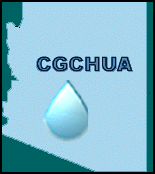 |
COOPERATORS - Cooperative States
Research, Education, and Extension Service |
|||||||||||||||||||||||||||||||
|
PUBLICATIONS Fox, F.A. Jr., E.C. Martin, D.C. Slack, and L.J. Clark. 1996. AZSCHED: Arizona Irrigation Scheduling. V1.3: User's Manual. The University of Arizona. Cooperative Extension Pub. #191049-3. Tucson, AZ. Anthony, B., J. Watson, R. Gibson , and S.W. Stedman. 1992. Agricultural Producer Survey Results: Casa Grande - Coolidge Hydrologic Unit Area Project. The University of Arizona, Cooperative Extension, Bulletin 192031. Arizona Water Series, Number 16. ACKNOWLEDGEMENTS The CGCHUA Project would like to acknowledge the efforts of the producers and cooperators who have assisted in research and extension projects over the past decade. CONTACTS For more information regarding the Casa Grande-Coolidge Hydrologic Unit Area, please contact Dr.Edward C. Martin via e-mail: You may also contact Dr. Martin at: Maricopa
Agricultural Center Phone: (520)
568 - 2273 The University of Arizona College of Agriculture is an equal opportunity employer authorized to provide research, educational information and other services only to individuals and institutions that function without regard to sex, race, religion, color, national origin, age, Vietnam Era Veteran's status, or handicapping condition. Any products, services, or organizations that are mentioned, shown, or indirectly implied in this publication do not imply endorsement by The University of Arizona. Maintained by: jsjones@ag.arizona.edu This document
located at: |




